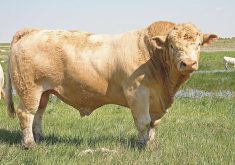Experts tell farmers with infected fields to thoroughly clean equipment before moving to a new field, but many question whether the time-consuming chore is worth it
Farmers in the epicentre of Western Canada’s clubroot infestation are easing back on containment efforts and betting resistant varieties will save the day — even as leading researchers are warning it could be a losing wager.
Since first being discovered in an Alberta field in 2003, the soil-borne disease has spread to more than 1,000 fields (covering 69,000 hectares) in 24 counties, as well as in Edmonton’s city boundaries. It has also spread to Manitoba and Saskatchewan.
The rapid spread caught researchers by surprise and comes despite calls for farmers to rigorously clean their equipment so soil contaminated with clubroot inoculum is kept out of clean fields.
Read Also

Grazing ‘sweet spot’ boosts pasture performance
Timing-focused approach to pasture management touted to boost forage growth, livestock gains while also cutting farmer labour and inputs
That’s what farm consultant Paul Muyres used to do whenever he entered a new field, even when both belonged to the same farmer. He developed a 16-item protocol for cleaning his truck, quad, and any other equipment he took from field to field.
“In an eight-hour day of scouting fields, I had four more hours (of cleaning,)” said Muyres, who is based in Beaumont, just south of Edmonton.
His clients used to insist on it, but no more, he said.
They are taking the approach that “if I have it in one field, it will be everywhere,” said Muyres, who now cleans his equipment only when moving to another farm.
The cleaning process recommended by experts was not only very time-consuming, but farmers question its effectiveness when infected dirt could be left on roads by other farmers or inoculum spread by blowing dirt and dust, he said.
“Farmers just assume they have the disease in the world that I live in,” said Muyers. “They grow clubroot-resistant varieties. End of story.”
Perhaps not, said scientists who gathered at the recent International Clubroot Workshop in Edmonton.
While resistant seed varieties, available since 2009, have proven to be very effective, “resistance is not immunity” and may also be short-lived, said plant pathologist Gary Peng.
The clubroot pathogen can adapt and change, and if spores are repeatedly exposed to the same resistant variety, a new strain may emerge that can overcome the resistance, said Peng, who works out of Agriculture and Agri-Food Canada’s Saskatoon research station.
Moreover, resistant varieties still lose yield — although not as much as non-resistant ones. As a rule of thumb, the Canola Council of Canada says clubroot cuts yields by about half of the percentage of infected stems. (If 100 per cent of the stems are infected, yield loss would be about 50 per cent. A 40-per-cent infection rate would cut yields by about 20 per cent.)
Since the number of spores (which can lay dormant for 20 years) increases with each canola crop, it’s recommended farmers take at least a two-year break between canola crops in the same field, and also rotate seed — alternating between the two sources of resistance currently available.
In Alberta, extensive measures have been put in place to prevent the spread of clubroot. In Leduc County, fieldmen inspect every canola field every year. Once clubroot is found, the farmer receives a notice which only allows canola to be grown one year in the four in that field, with only clubroot-resistant varieties allowed.
In Manitoba, officials are pondering how to deal with widespread infestation, which looks increasingly likely.
“Manitoba is no longer clubroot free,” Holly Derksen, field crop pathologist with Manitoba Agriculture, Food and Rural Initiatives reminded delegates at the Edmonton workshop.
Spores were first found in 2005 through the Manitoba Canola Disease Survey. Last year, the disease was found in six fields and “there’s definitely more than that out there,” she said.
For now, provincial staff are dealing with farmers with infected land on “an individual basis,” she said. However, if clubroot was included in the provincial Plant Pests and Diseases Act, municipalities could publicize the location of infected fields.
But officials are holding off on that step because the canola disease survey is voluntary and the farmers whose fields have tested positive tend to be “prepared and willing to work with MAFRI,” she said.
Tiny and hardy, clubroot spores become active when there are secretions from the roots of desirable brassica crops or weeds (including mustard, wild mustard, shepherd’s purse, broccoli and cabbage).
Germinated spores, or zoospores, attach themselves to plant root hairs and then produce more zoospores as well as ‘clubs’ or ‘galls,’ which restrict the flow of nutrients and water to aboveground plant tissues.
When the galls decay, resting clubroot spores are released into the soil. One infected plant root can generate billions of resting spores.














